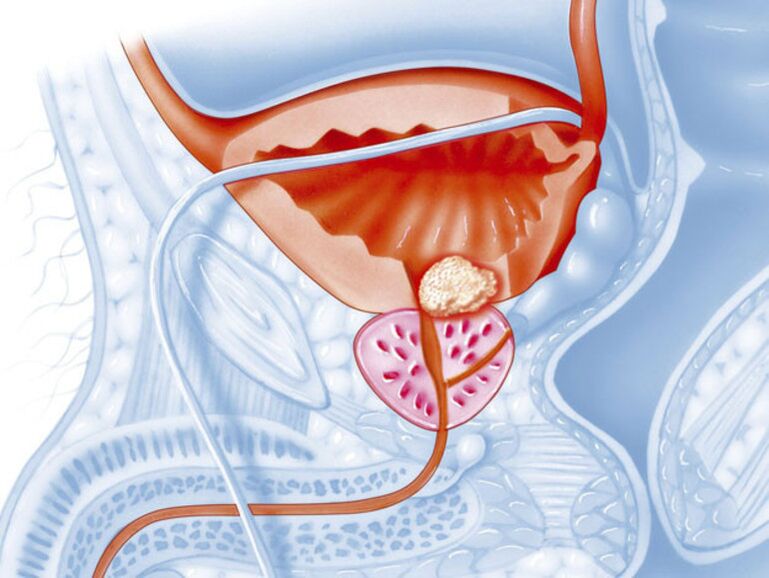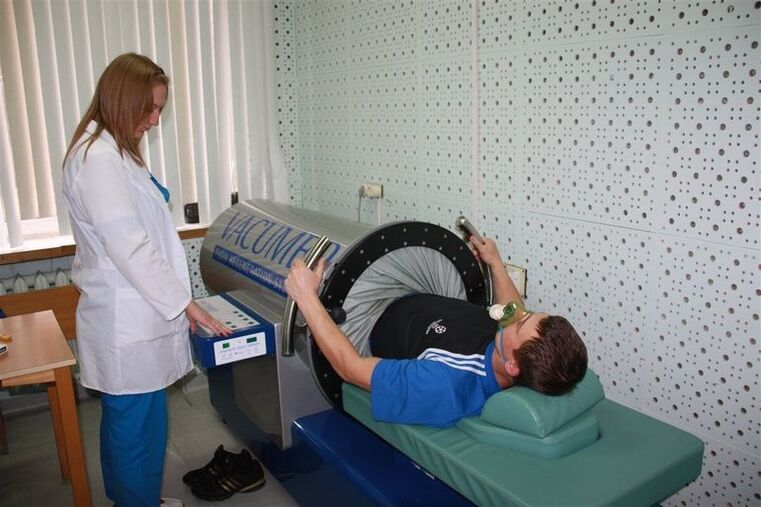Middle-aged and elderly men often suffer from pathologies of the genitourinary system associated with the prostate. This organ is prone to inflammatory processes that cause serious discomfort. The most common pathology is chronic prostatitis. It is difficult to treat and is accompanied by severe clinical manifestations.

Causes of pathology
According to statistics, about 30% of men of reproductive age suffer from one form or another of prostatitis. In almost 70% of cases, the disease is asymptomatic, which makes it dangerous for health.There are many reasons for the development of pathology:

- Ignoring the symptoms of the acute form of the disease often leads to its transition to the chronic stage with periodic relapses.
- Regular hypothermia of the body and frequent catarrhal pathologies provoke inflammation of the gland.
- A sedentary lifestyle causes stagnation of blood in the pelvis and leads to interruption of blood supply to the prostate. If a man's professional activity is associated with a constant sitting position, the probability of developing prostatitis increases several times.
- Choosing tight underwear that squeezes the genitals.
- Bad habits (alcohol abuse, smoking) often cause the development of pathology, as they contribute to the disruption of all vital processes in the body.
- Chronic infectious diseases of the urinary system can also cause inflammation of the gland.
- Venereal pathologies of acute and chronic forms. If the recommendations of a specialist are violated or the symptoms of the disease are ignored, the infection can spread to the gland.
- Frequent stress and nervous exhaustion. Such factors can provoke pathology, especially with a simultaneous decrease in immunity.
- The lack of minerals and vitamins in the daily diet can be a predisposing factor. If the deficiency is permanent, other diseases join the chronic prostatitis.
Rare sexual intercourse and the absence of a permanent partner increase the risk of developing chronic prostatitis. Treatment in this case is also delayed, as the patient experiences not only physical but also emotional discomfort.
Disease classification

Depending on the cause of the onset and course of the pathological process, there are two types of disease: bacterial and non-bacterial. Separately, experts distinguish asymptomatic or atonic prostatitis. Each species has its own characteristics.
Bacterial prostatitis is easy to detect during a diagnostic exam. Tests usually show the source of the inflammation. There are especially many pathogens in the secret released during gland massage. In the blood, the level of leukocytes is almost always high, as the body produces them in large quantities to fight pathogens.
The non-bacterial form of the pathology is characterized by a milder course, but almost always the patient suffers from severe pain in the small pelvis. It is pelvic pain syndrome that is considered the main criterion for diagnosis.
It is very difficult to identify the asymptomatic type of the disease as there are no obvious signs of inflammation. Pathological changes occur in the prostate, but the man does not feel them. A specialist makes a diagnosis by chance or during an examination for other pathologies.
Clinical condition
In the acute form of the pathology, a man immediately feels a deterioration in his condition, but in the case of chronic prostatitis, there may be no symptoms, which greatly complicates the diagnosis.With the prolonged progression of the disease, the following symptoms appear:

- discomfort during urination, extending to the projection area of the bladder;
- frequent urge to void with a simultaneous decrease in the amount of urine excreted;
- discomfort during intercourse, erection and ejaculation problems;
- a feeling of incomplete emptying of the bladder associated with a narrowing of the duct, causing prolonged but unproductive urination;
- the development of cystitis, pyelonephritis associated with the multiplication of bacteria in the bladder and the spread of the infection to the kidneys;
- change in urine color, appearance of blood impurities or pus;
- decreased libido;
- general weakness, fatigue, decreased performance;
- irritability and psycho-emotional stress;
- slight increase in body temperature;
- pain in the pelvis and scrotum, radiating to the sacrum or rectum.
The severity of symptoms depends on the degree of damage to prostate tissues. Sometimes the patient has only pain and no other manifestations.
If the patient does not go to the doctor for a long time, he may develop complications. The most common of these is vesiculitis, or inflammation of the seminal vesicles. Often, when symptoms of chronic prostatitis appear at a young age, patients are diagnosed with infertility, which is difficult to treat.
The most dangerous consequence of undertreated or neglected prostatitis is prostate cancer. Often, a benign pathology of the organ develops - an adenoma, which can also turn into a malignant tumor.
diagnostic methods
Before treating chronic prostatitis, it is necessary to undergo a comprehensive diagnostic examination. During the initial treatment, the specialist interviews the patient, learns about habits, lifestyle characteristics, frequency of sexual contacts and professional activities. The information helps to identify the suspected cause of the disease. Then the doctor listens to the patient's complaints and determines the degree of damage to the gland.

The next step in diagnosis is clinical blood and urine tests. They usually show an increase in the number of leukocytes and an increase in the erythrocyte sedimentation rate. This indicates the presence of an inflammatory process in a man.
The patient must undergo radiographic examinationprostate and ultrasound. Thanks to these methods, you can see changes in the structure of the body, deviations in one direction or another. In addition, computed tomography can be performed to identify concomitant pathologies of the genitourinary system.
If a tumor is suspected, a biopsy sample should be taken. In the laboratory, specialists study the cell's structure and make a final diagnosis. If the tumor is benign, doctors also determine the probability of its malignancy being malignant. After receiving the results of the diagnostic examination, the specialist determines the direction of therapy.
medical therapy
Treatment of chronic prostatitis with medication is considered the most common form. Doctors always choose a conservative method if a cure is possible.The most used drugs are:
- Antibacterial agents can alleviate inflammation in a short time and prevent the process from spreading to neighboring organs. Most often, tablet forms of penicillins and fluoroquinolones are used. When the form is running, a powder is prescribed to prepare the solution. The drug is administered intravenously or intramuscularly in a hospital setting. With the ineffectiveness of these drugs, macrolides are used, which have a stronger effect. Popular drugs of this group are available in the form of tablets and lyophilisates for the preparation of a solution for injection. The course of therapy lasts from 10 to 20 days, depending on the severity of the condition.
- Non-steroidal anti-inflammatory drugs are prescribed to relieve pain and prevent the development of the pathological process. The course usually does not exceed 7 days. Patients with digestive tract pathologies should not take these drugs without first consulting a doctor.
- Muscle relaxants help relax smooth muscles and make urination easier. Duration of therapy and dosage is determined by the physician.
- Rectal suppositories relieve swelling, pain and inflammation, improve the general condition of the patient. The duration of the therapeutic effect is 10-14 days.
In addition, the therapy regimen includes vitamin complexes to strengthen the immune system and quickly restore the body after treatment. Among these funds is a complex designed specifically for men. The minimum duration of the course of its reception is 30 days.
Surgical intervention

If it is impossible to cure the pathology conservatively, the doctor decides to perform an operation to remove all or part of the organ. The absolute indication for surgical intervention is prostate cancer.
The transurethral resection method consists of dissecting the urethra and removing part of the gland to relieve the condition. If removal is not necessary, a simple organ dissection is performed to normalize urination.
The open adenomectomy method is used with a significant growth of the gland and the addition of other pathologies. The operation is performed under general anesthesia. The technique is mostly used to treat elderly patients, when other means and interventions have been ineffective.
use of physical therapy

In parallel with drug treatment, physical therapy is often used to speed recovery and prevent complications.The most popular and effective method is massage.prostate through the rectum. The technique improves the blood supply and nutrition of the organ, prevents the spread of inflammation to neighboring organs.
To achieve a therapeutic effect, it is necessary to carry out at least 10 sessions. The procedure is performed by a specialist in a hospital or clinic.
Electrophoresis in the area of projection of the prostate allows to normalize the flow of blood to it. The essence of the technique is the use of low-frequency electrical current, which has a positive effect on the state of the genitourinary system, stimulates tissue regeneration and relieves inflammation. The course is a minimum of 10 sessions, sometimes more procedures are needed to get a lasting result.
Ultrasound and laser therapy, paraffin therapy, and other methods are often prescribed. The choice of treatment method depends on the individual characteristics of the patient's body.
prevention measures
Compliance with simple rules will help to prevent the development of chronic prostatitis. It is recommended to avoid hypothermia, lead an active lifestyle. You shouldn't torture the body with intense exercise, but moderate and regular exercise will help to prevent stagnation of blood in the pelvis and the development of prostatitis.
Experts recommend including pumpkin seeds, fresh vegetables, fruits and herbs in your diet. Do not abuse alcoholic beverages. Quitting smoking will reduce the risk of developing an inflammatory process. A balanced diet will help maintain the immune system, prevent colds and viral pathologies.
To prevent prostatitis, it is necessary to visit a urologist every 6 months. This will detect the pathology at an early stage and prevent its transition to a neglected form. When the first signs of the disease appear, you should contact a medical institution to start therapy in a timely manner and avoid complications.





























